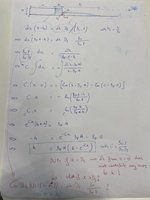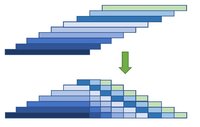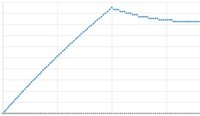You are using an out of date browser. It may not display this or other websites correctly.
You should upgrade or use an alternative browser.
You should upgrade or use an alternative browser.
differential equation of a function determined by own increment at x-A
- Thread starter fogoetha
- Start date
You had a beautiful differential equation in the first part.
Do you mean this?
[MATH]\frac{dy}{dx} = \frac{(H - By)}{A}[/MATH]
In the second part. I don't understand your differential equation.
Do you mean this?
[MATH]\frac{dy}{dx} = \frac{H - By + B \ dy}{A}[/MATH]
I am sorry, but this is not a correct differential equation!
Do you mean this?
[MATH]\frac{dy}{dx} = \frac{(H - By)}{A}[/MATH]
In the second part. I don't understand your differential equation.
Do you mean this?
[MATH]\frac{dy}{dx} = \frac{H - By + B \ dy}{A}[/MATH]
I am sorry, but this is not a correct differential equation!
You had a beautiful differential equation in the first part.
Do you mean this?
[MATH]\frac{dy}{dx} = \frac{(H - By)}{A}[/MATH]
In the second part. I don't understand your differential equation.
Do you mean this?
[MATH]\frac{dy}{dx} = \frac{H - By + B \ dy}{A}[/MATH]
I am sorry, but this is not a correct differential equation!
Dear @nasi112
Yes, I indicated that the formulation was inadequate.
but you also mean that the equation proposed by you is not even a valid formulation? This can be easily rewritten to contain only one 'dy', so I don't see the problem.
The real problem is that the additional dy should not refer to 'x' but to 'x-A'. I don't know how to incorporate this.
D
Deleted member 4993
Guest
What is the context of the problem? In other words, how did this problem arise - how was it formulated?Hi everyone,
I posted below question on mathforums.com half a year ago, but never got any reponse. So I hope someone can help me out here:
View attachment 27722
kind regards
Frederik
Show me how will you do it.Dear @nasi112
Yes, I indicated that the formulation was inadequate.
but you also mean that the equation proposed by you is not even a valid formulation? This can be easily rewritten to contain only one 'dy', so I don't see the problem.
The real problem is that the additional dy should not refer to 'x' but to 'x-A'. I don't know how to incorporate this.
D
Deleted member 4993
Guest
Dear @nasi112
Yes, I indicated that the formulation was inadequate.
but you also mean that the equation proposed by you is not even a valid formulation? This can be easily rewritten to contain only one 'dy', so I don't see the problem.
The real problem is that the additional dy should not refer to 'x' but to 'x-A'. I don't know how to incorporate this.
What is the context of the problem? In other words, how did this problem arise - how was it formulated?
Please answer the question/s posed above.
HallsofIvy
Elite Member
- Joined
- Jan 27, 2012
- Messages
- 7,760
The problem is where you say,
"But, once x> A, the differential dy, valid at x- A, needs to be subtracted."
That's impossible! You can't subtract a differential from a function. Although differentials can be multiplied by a function, they can only be added to or subtracted from other differentials.
That's why you are being asked about the precise statement of the problem.
"But, once x> A, the differential dy, valid at x- A, needs to be subtracted."
That's impossible! You can't subtract a differential from a function. Although differentials can be multiplied by a function, they can only be added to or subtracted from other differentials.
That's why you are being asked about the precise statement of the problem.
First of all, you are incorrect right at the beginning.
[MATH]a * dy = (h - by)dx \implies \dfrac{dy}{h - by} = \dfrac{1}{a} * dx \implies \int \dfrac{-b * dy}{h - by} = - \int \dfrac{b}{a} * dx \implies[/MATH]
[MATH]ln(h - by)= \dfrac{-bx}{a} + c = \dfrac{-bx}{a} + ln(k) \implies ln \left ( \dfrac{h - by}{k} \right ) = \dfrac{-bx}{a} \implies [/MATH]
[MATH]\dfrac{h - by}{k} = e^{-bx/a} \implies h - k * e^{-bx/a} = by \implies y = \dfrac{h}{b} * \left (1 - \dfrac{k}{h} * e^{-bx/a} \right ).[/MATH]
Because I am no expert in differential equations and because my answer disagrees with yours, let’s check my work.
[MATH]y = \dfrac{h}{b} * \left (1 - \dfrac{k}{h} * e^{-bx/a} \right ) \implies \dfrac{by}{h} = 1 - \dfrac{k}{h} * e^{-bx/a} \implies k * e^{-bx/a} = h - by.[/MATH]
[MATH]\text {Also, } y = \dfrac{h}{b} * \left (1 - \dfrac{k}{h} * e^{-bx/a} \right ) \implies \dfrac{dy}{dx} = \dfrac{h}{b} * \dfrac{-b}{a} * (-1) * \dfrac{k}{h} * e^{-bx/a} = \dfrac{1}{a} * k * e^{-bx/a} \implies[/MATH]
[MATH]a \ dy = (h - by) \ dx.[/MATH]
In other words, you defined your constant of integration as e^b. Either that is totally arbitrary, or you have provided insufficient information.
Now the only way that I can make sense of the rest of your post is that y is defined piecewise and that where you wrote x - A you meant x = A.
And [MATH]x = a \implies y = \dfrac{h}{b} \left ( 1 - \dfrac{k}{h} e^{-b} \right ) = \text {some constant} = d.[/MATH]
Now for what you mean when x > a, I can imagine several things. The most plausible is
[MATH]a \ dy = (h + bd - by) \ dx[/MATH].
Now that is soluble. The constant of integration will probably have to be constrained to make y continuous and there is still the mysterious k to deal with.
I hope this contributes somewhat to clarifying why you are getting so little response to your problem. The best I can do is to guess that your problem involves a continuous function defined piecewise by different differential equations. You will need to supply considerably more information to make progress, and I am a duffer at differential equations.
[MATH]a * dy = (h - by)dx \implies \dfrac{dy}{h - by} = \dfrac{1}{a} * dx \implies \int \dfrac{-b * dy}{h - by} = - \int \dfrac{b}{a} * dx \implies[/MATH]
[MATH]ln(h - by)= \dfrac{-bx}{a} + c = \dfrac{-bx}{a} + ln(k) \implies ln \left ( \dfrac{h - by}{k} \right ) = \dfrac{-bx}{a} \implies [/MATH]
[MATH]\dfrac{h - by}{k} = e^{-bx/a} \implies h - k * e^{-bx/a} = by \implies y = \dfrac{h}{b} * \left (1 - \dfrac{k}{h} * e^{-bx/a} \right ).[/MATH]
Because I am no expert in differential equations and because my answer disagrees with yours, let’s check my work.
[MATH]y = \dfrac{h}{b} * \left (1 - \dfrac{k}{h} * e^{-bx/a} \right ) \implies \dfrac{by}{h} = 1 - \dfrac{k}{h} * e^{-bx/a} \implies k * e^{-bx/a} = h - by.[/MATH]
[MATH]\text {Also, } y = \dfrac{h}{b} * \left (1 - \dfrac{k}{h} * e^{-bx/a} \right ) \implies \dfrac{dy}{dx} = \dfrac{h}{b} * \dfrac{-b}{a} * (-1) * \dfrac{k}{h} * e^{-bx/a} = \dfrac{1}{a} * k * e^{-bx/a} \implies[/MATH]
[MATH]a \ dy = (h - by) \ dx.[/MATH]
In other words, you defined your constant of integration as e^b. Either that is totally arbitrary, or you have provided insufficient information.
Now the only way that I can make sense of the rest of your post is that y is defined piecewise and that where you wrote x - A you meant x = A.
And [MATH]x = a \implies y = \dfrac{h}{b} \left ( 1 - \dfrac{k}{h} e^{-b} \right ) = \text {some constant} = d.[/MATH]
Now for what you mean when x > a, I can imagine several things. The most plausible is
[MATH]a \ dy = (h + bd - by) \ dx[/MATH].
Now that is soluble. The constant of integration will probably have to be constrained to make y continuous and there is still the mysterious k to deal with.
I hope this contributes somewhat to clarifying why you are getting so little response to your problem. The best I can do is to guess that your problem involves a continuous function defined piecewise by different differential equations. You will need to supply considerably more information to make progress, and I am a duffer at differential equations.
What is the context of the problem? In other words, how did this problem arise - how was it formulated?
Hi Subhotosh Khan, hi everyone,
thank you all for responding and asking the right questions. Sorry to keep you waiting.
I realize it was a long shot hoping to receive adequate input while submitting this problem without context, but I was restricted in available time.
Further on, I will go into more detail on the formulation using more and other names/symbols for certain parameters, so please disregard the equations shown in my previous posts as I simplified/generalized them.
Anyway, I will try to concisely explain the physical mechanism this problem arises from:
It's all about soil mechanics and hydraulics and their interaction. See first image below. There's a small sketch showing a longitudinal (in the direction of the filling progress) profile along a layer of soil gradually placed from a pumped soil-water mixture from left to right. The soil particles consist of 2 grain sizes: sand (coarse) and silt (fine). The sand will settle rather immediately from the mixture and the process is controlled such that the height of that sand layer equals 'H'. On the other hand, the silt takes more time to settle on the bottom and flows further and is here assumed to settle equally (same thickness) along a distance = Ds. As the process evolves, the sand will be placed on top of the increasing layer of settled silt, burying it. this leads to a buried thickness (height) hb, which is smaller than h, the height of the silt settled just in front of the progressing sand layer. This is due to a change in the volume of pores between the particles, expressed by a so-called bulking factor BF.
Now, what I'd like to know is an expression that represents the unburied height of the silt layer (at the sand front) for a certain progress of the filling process. In short: 'h' as a function of 'x'. In the picture below you can find my formulations of the corresponding math. I'd like to think this is a solid derivation of the described process. Apart from hb, h and x all symbols represent constants (e.g. bulking factors and fine to coarse ratio).
The formulation of the differential equation is based on the fact that, apart from factors Bu and F, both green hatched areas (incremental volumes of sand vs silt) have the same size. For every 'dx', a 'dh' is added to 'h'.

HOWEVER, above formulation is only valid as long as x < Ds. This is due to the fact that, from that point onwards, 'h' is not the sum any more of all previously settled dh. This is what the red text aims to point out. Although too simplified, the problem i want to convey is demonstrated in the small sketch below:

Hence my attempt to again subtract the 'dh' from previous steps in the differential equation. It cannot be as simple as subtracting h(x - Ds) from h(x).
Based on numerical calculations, the graph of the function should be something like this:

I expect a periodic function much like a damped oscillator, eventually converging to a certain value...
So please, enlighten me
Thanks!
Hi, thanks for the reply. I provide an elaborate answer to Subhotosh Khan's post above.The problem is where you say,
"But, once x> A, the differential dy, valid at x- A, needs to be subtracted."
That's impossible! You can't subtract a differential from a function. Although differentials can be multiplied by a function, they can only be added to or subtracted from other differentials.
That's why you are being asked about the precise statement of the problem.
First of all, you are incorrect right at the beginning.
[MATH]a * dy = (h - by)dx \implies \dfrac{dy}{h - by} = \dfrac{1}{a} * dx \implies \int \dfrac{-b * dy}{h - by} = - \int \dfrac{b}{a} * dx \implies[/MATH]
[MATH]ln(h - by)= \dfrac{-bx}{a} + c = \dfrac{-bx}{a} + ln(k) \implies ln \left ( \dfrac{h - by}{k} \right ) = \dfrac{-bx}{a} \implies [/MATH]
[MATH]\dfrac{h - by}{k} = e^{-bx/a} \implies h - k * e^{-bx/a} = by \implies y = \dfrac{h}{b} * \left (1 - \dfrac{k}{h} * e^{-bx/a} \right ).[/MATH]
Because I am no expert in differential equations and because my answer disagrees with yours, let’s check my work.
[MATH]y = \dfrac{h}{b} * \left (1 - \dfrac{k}{h} * e^{-bx/a} \right ) \implies \dfrac{by}{h} = 1 - \dfrac{k}{h} * e^{-bx/a} \implies k * e^{-bx/a} = h - by.[/MATH]
[MATH]\text {Also, } y = \dfrac{h}{b} * \left (1 - \dfrac{k}{h} * e^{-bx/a} \right ) \implies \dfrac{dy}{dx} = \dfrac{h}{b} * \dfrac{-b}{a} * (-1) * \dfrac{k}{h} * e^{-bx/a} = \dfrac{1}{a} * k * e^{-bx/a} \implies[/MATH]
[MATH]a \ dy = (h - by) \ dx.[/MATH]
In other words, you defined your constant of integration as e^b. Either that is totally arbitrary, or you have provided insufficient information.
Now the only way that I can make sense of the rest of your post is that y is defined piecewise and that where you wrote x - A you meant x = A.
And [MATH]x = a \implies y = \dfrac{h}{b} \left ( 1 - \dfrac{k}{h} e^{-b} \right ) = \text {some constant} = d.[/MATH]
Now for what you mean when x > a, I can imagine several things. The most plausible is
[MATH]a \ dy = (h + bd - by) \ dx[/MATH].
Now that is soluble. The constant of integration will probably have to be constrained to make y continuous and there is still the mysterious k to deal with.
I hope this contributes somewhat to clarifying why you are getting so little response to your problem. The best I can do is to guess that your problem involves a continuous function defined piecewise by different differential equations. You will need to supply considerably more information to make progress, and I am a duffer at differential equations.
Indeed, I did not bother to properly include integration boundaries.
See my other post for an elaborate answer on the whole formulation and derivations.
UPDATE:
After 6 months, I finally got a response on mathforums.com, and although it contains some major errors, it seems to point out that I just made a simple mistake in my line of thought when it comes to differentials: Rather than trying to add or subtract 'dh' from h, I have to subtract the derivative function (if that is the correct english term) h'(x) from h(x). But, as explained above, the derivative has to be considered in point (x - Ds) , instead of x. I will work it out and post my results here later on.
After 6 months, I finally got a response on mathforums.com, and although it contains some major errors, it seems to point out that I just made a simple mistake in my line of thought when it comes to differentials: Rather than trying to add or subtract 'dh' from h, I have to subtract the derivative function (if that is the correct english term) h'(x) from h(x). But, as explained above, the derivative has to be considered in point (x - Ds) , instead of x. I will work it out and post my results here later on.

